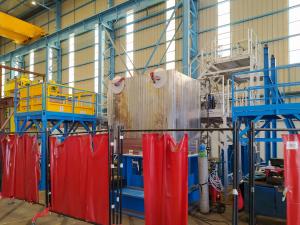Diagnostic port plugs: First units near completion
The first two diagnostic port plug structures will be sent to ITER Domestic Agencies to be equipped with diagnostics and other hardware.
To an outside observer, port plug structures look like hollow boxes about the size of a bus. But when fully equipped, those boxes will hold diagnostics, integrated services, and other hardware. While the port plug structures are made with ITER-grade austenitic stainless steel to withstand neutrons fluxes and other hazards, the equipment inside will be shielded with steel and boron carbide to provide an extra layer of protection.
Two standard types of port plugs are planned—large square models for the upper ports, and smaller, elongated versions for the equatorial ports. A total of 23 diagnostic ports will require port plug structures.
The final design was completed in 2015. Then, in October 2016, the ITER Organization awarded a manufacturing contract to CNIM, a company in Toulon, France, just a ninety-minute drive from the ITER site. The team at CNIM is now nearing the final stages of manufacturing for the first two equatorial port plug structures, which will be delivered to the Russian and Chinese Domestic Agencies. The agencies, in turn, will begin loading them with the equipment they are designed to hold.
"It's important to manufacture these big boxes now because they are the very first step in the integration of the entire port," says Victor Udintsev, who leads the Diagnostic Engineering Section. "We cannot assemble anything that goes into the machine without these boxes."
"There has been a strong collaboration between the ITER Organization and the Domestic Agencies on the structures. Everybody was involved in the design reviews and the planning of port integration; now ITER is doing the port integration, with close involvement from the Domestic Agencies. They are the customers—and ITER acts as the manufacturer, contracting the work out to CNIM."
While each of the port plug structures adheres to one of two standard designs, small adjustments will be made depending on the diagnostics encased in each port. "Some diagnostics look to the left of the machine, some to the right," says Victor. "Some sense light in the microwave range; some use light in the visual range." Differences such as these require customizations—including, for example, additional windows and adjustments to the diameters and locations of the holes in the back wall where components are attached.
Building strong structures with tight tolerances
The most technologically advanced electron beam welding is used during manufacturing to ensure a high-quality and low distortion weld that respects very tight tolerances. The port plug structures must be very straight and when inserted in the machine, the ensuing gap around the structure must be just the right size—large enough to allow the port plug to be pulled back out, but small enough to minimize the passage of neutrons.
Basic tests will be run before the port plug structures are sent out for integration—for example, a pressure test and a helium leak test will ensure the cooling circuits have no leaks or cracks, and that they are unlikely to develop cracks in the future. Then after the components are integrated inside the structures and sent back to ITER, final tests will be carried out at the Port Integration Facility on site.
It would be relatively easy to insert an empty port plug structure in the vacuum vessel. The structures themselves weigh up to 10 tonnes, plus or minus a few hundred kilograms, depending on the number of cutouts. But it is a different story when the port plug is assembled, bringing the weight of the entire structure to about 48 tonnes for the equatorial ports and 25 tonnes for the upper ports. A fully integrated port has a different centre of gravity and could suffer from deadweight distortion if the port plug structure is not built to be strong enough.
The port plug structures include a flange, which connects to the flange of the vacuum vessel itself. "Remote handling equipment will bring the port plug to the machine and plug it in like a cork in a bottle," says Udintsev. "You put it inside, bolt it on the perimeter with the sealing gasket in-between and then you are done." For repairs, remote handling will be used to unbolt the flange and put the giant box into a cask to bring it to the Hot Cell Facility where the port can be refurbished.
CNIM is using a staged approach to manufacturing port plug structures, beginning with the first two that will be sent to ITER China and ITER Russia. Over the next few years, the other 21 port plug structures will be procured and delivered to Domestic Agencies—or to ITER itself—to be completely assembled as integrated ports. ITER is responsible for integration of three equatorial and three upper diagnostic port plugs.
Delivery of the first two port plugs marks the beginning of a new phase.


